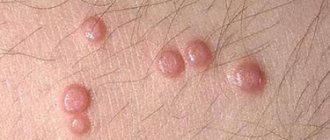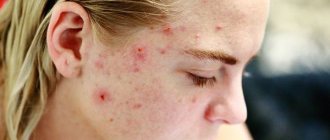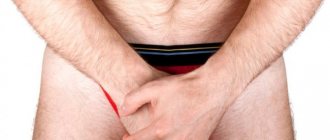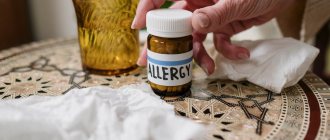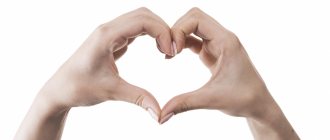Pustule
– inflammatory formation on the skin with purulent contents. It is formed as a result of various infectious diseases: herpes, chickenpox, fungal infections. Among the diseases that provoke the appearance of pustules, candidiasis, folliculitis, psoriasis, acne, and scabies should also be noted.
The main reason for the appearance of pustules on the face is an attack of the body by pathogenic microorganisms (streptococci or staphylococci). Neoplasms are localized in various parts of the body, most often on the face, back, and shoulders.
How papules and pustules appear
The mechanism of pimple formation is very simple. Due to the increased secretion of sebum - sebum - the sebaceous gland duct is blocked. A sebaceous plug is formed, that is, a comedon; they can be open or closed. But if such a comedon is affected by the bacteria P. Acnes, then inflammation occurs; over time, the purulent contents break into the skin, spread, which leads to the formation of other papules, and with more severe inflammation, purulent pustules appear.
There are many reasons for such activity of the sebaceous glands, the most common being hormonal changes during puberty. Nutrition, stress, hygiene habits, and lifestyle also play a role.
Cause of pustules
If a pustule appears on the skin, the reasons for its occurrence can be very different. The main cause is staphylococcus and streptococcus bacteria. Pustules also occur in certain diseases: chicken pox, candidiasis (fungal disease), dyshidrosis (chronic allergy), acne (acne), as well as scabies, plague, syphilis, etc. But as all doctors unanimously say: the main cause of skin rashes is a decrease in the body’s immunity. Therefore, the appearance of skin rashes should be a cause for concern. And only a dermatologist, after taking tests, will be able to say with accuracy what caused the appearance of pustules in the dermis or epidermis.
Acne
Acne is a disease in which papules, pustules, and comedones appear on the face and body (several follicles are affected at once). The inflammation is widespread, often the pimples are painful to touch, and as soon as one goes away, others appear. If a person has only comedones - white and blackheads, then we are talking about a non-inflammatory type of acne. And if there are papules and pustules, cysts, this is an inflammatory type. Pustules on the face should not be pressed, this will only worsen the situation; the contents may not break out, but subcutaneously.
It is worth saying that papules and pustules can appear not only as part of acne, for example, papular dermatosis with sterile papules is sometimes found, that is, P. Acnes is not detected in them, but acne is still the most common cause. Papular rashes also occur with psoriasis.
Treatment
Treatment of pustules should be aimed at eliminating the symptoms of the disease that caused their appearance. For this purpose, complex therapy is used, which includes antibacterial drugs, retinoids (synthesized analogues of vitamin A), antifungal agents, and vitamin complexes.
Contacting our medical and cosmetic center guarantees accurate diagnosis and selection of the most effective means to solve an unpleasant problem. When prescribing drug treatment, our specialists take into account the individual health characteristics of patients, the severity of the disease, the tendency to allergic reactions and other factors.
To consolidate successful treatment results, our specialists prepare recommendations for skin care and following a special diet.
How to treat papules and pustules
Now that we have found out what papules and pustules are, the question arises whether they need to be treated. In this case, everything depends on their number and frequency of occurrence. If they are isolated and rarely appear on the face and body, for example, due to hormonal changes during the menstrual cycle, then there is no need to worry. You can simply choose suitable care cosmetics from a cosmetologist and cleanse your face efficiently. But if there are a lot of rashes, they can merge together and form spots; papules and pustules should be treated by a dermatologist.
Treatment of acne, papules and pustules is complex.
Lifestyle adjustments and adherence to doctor's recommendations are required. A non-hormonal ointment is used as a local remedy, which does not cause withdrawal effects in the future. Before treatment, the doctor will prescribe tests for hormones, the content of certain vitamins and a general blood test. This way you can choose an individual treatment plan. June 23, 2020
Author of the article: dermatologist Mak Vladimir Fedorovich
Difference between papules and pustules
You can recognize the formations yourself by reading the list of their external manifestations. By contacting a specialist, you will be able to correctly identify the nature of the rash and assess your health status. The doctor determines the difference between a papule and a pustule by the location of the formations, signs of development, and appearance.
Need advice from an experienced doctor?
Get a doctor's consultation online. Ask your question right now.
Ask a free question
To prescribe therapy, minimize the likelihood of worsening the situation due to self-medication, and prevent undesirable consequences, become familiar with the characteristic signs of nodules and the symptoms of pustules.
Appearance
The papule resembles a small round, oval or cone-shaped nodule with clear boundaries. The size of the defect, like pustules, varies from a few mm to 3 centimeters in diameter. The formations may rise above the skin or remain flat and inconspicuous. The attributes have a dense, elastic structure.
The color of the papules varies depending on the disease that caused it, and can range from pearly white to pronounced red. The main difference from a pustule is the absence of purulent contents. When you press on the formation, it turns pale, the manipulation does not cause pain. Sometimes swelling of the skin is observed, and when the attributes merge, plaques form.
Pustules are pimples ranging in size from a pin to a pea with a pronounced head with purulent contents, unlike papules. When the shell breaks through, the mass comes out, and the resulting wound becomes covered with a crust. If the formation is single, there are no associated ailments, the problem area of the skin is quickly restored. When multiple foci of inflammation are observed, the attributes can merge, leading to an extensive pathological process that provokes scarring on the skin.
Pustules and papules are often confused with vesicles - small bubbles with exudate.
Reasons for education
The appearance of pustules is promoted by unfavorable external and internal factors. They are often the result of blockage of the sebaceous ducts with the contents spreading under the skin. Papules are provoked by infectious diseases affecting the body (molluscum contagiosum, syphilis, herpes, HPV, phthiriasis).
With acne, pustules, vesicles, and comedones are found on the face.
There are many reasons for the occurrence of rashes. The development of skin nodules is influenced by unfavorable environmental factors and internal changes accompanied by infectious invasions. The main causes of damage to the epidermis by pustules and papules:
- The introduction of a bacterial pathogen through microtrauma from the use of contaminated razors, touching the skin with unwashed hands, and the use of other people's hygiene products.
- Excessive sweating, causing microscopic damage to the surface.
- Problems with metabolic processes can cause pustules. Disruption of the systems responsible for metabolism contributes to the development of papules.
- Hormonal imbalances that often affect women. The occurrence of acne is observed during menstruation, puberty in adolescents, pregnancy, when the body undergoes restructuring.
- Taking medications. Drugs that affect the functioning of the endocrine system can trigger the formation of pustules on the skin.
- Immune suppression. Diseases accompanied by a decrease in the body's defense mechanisms lead to the appearance of papules and activation of viral processes.
To determine the cause of the appearance of tumors, diagnostics are carried out at a medical center.
Localization
Papules can appear on any part of the skin, depending on the disease that caused the rash. Pustules appear on the face, trunk, and limbs.
When the body is affected by molluscum contagiosum, nodules cover the scalp, abdomen, limbs, and genitals. Pearlescent pimples are located around the head of the penis. Formations caused by syphilis affect the torso, anogenital area, and oral cavity. Wart formations, which are often confused with papules and pustules, appear on the backs of the palms and fingers.
Based on the severity of the damage to the epidermal layer, formations are divided into superficial and deep.
For pustules, the typical location is the skin where the hair is located. The follicles become a cavity for the accumulation of purulent mass; often abscesses form on the chin, forehead, neck, armpits, groin area, in place of the papule.
With pustular psoriasis, there are attributes on the heels and palms. Based on the depth of penetration into the skin, ulcers are divided into dermal and epidermal.
Signs
The occurrence of formations is accompanied by characteristic signs and symptoms that help to recognize the nature of the element and prescribe treatment for pustules or papules.
When nodules occur without an inflammatory process, the skin does not change its original appearance. An element of dense consistency is formed on the surface, hardly noticeable against the general background. Before a rash occurs, the epidermis acquires a red tint, becomes swollen, hot, causing itching. The presence of pain in the area affected by the papule depends on the disease that caused the appearance of the elements.
Pustules, like purulent formations, begin to develop with redness, thickening appears on the skin, accompanied by burning, itching, and swelling of the tissues. When the abscess matures, a white rod appears, tension in the skin in the area of the attribute, and discomfort are felt. Depending on the size and location, pain and symptoms of general intoxication may be present, in contrast to papular formations.
Why do papulopustular acne appear?
Heredity influences how acne develops and progresses. There is a genetic predisposition to hyperandrogenism, hypersensitivity of the sebaceous gland receptors to androgens, increased activity of 5-alpha reductase, which is involved in the conversion of testosterone to DHT. It is DHT that helps increase sebum production.29
Inflammation in acne can be either aseptic, developing in sterile conditions, or reactions to substances produced by propionibacteria. 29
Clindovit® gel is a topical antibiotic. Its main active ingredient is clindamycin phosphate. The drug exhibits antimicrobial activity against propionibacteria.6
The causes of acne can be associated with diseases of internal organs and systems, for example, the gastrointestinal tract; rashes can be a consequence of dysbacteriosis, hypovitaminosis, metabolic disorders, and decreased immunity. 29
The causes and treatment of acne are interrelated. So, if the rashes in women are of a hormonal nature, in addition to topical therapy, oral contraceptives may be prescribed. 29
